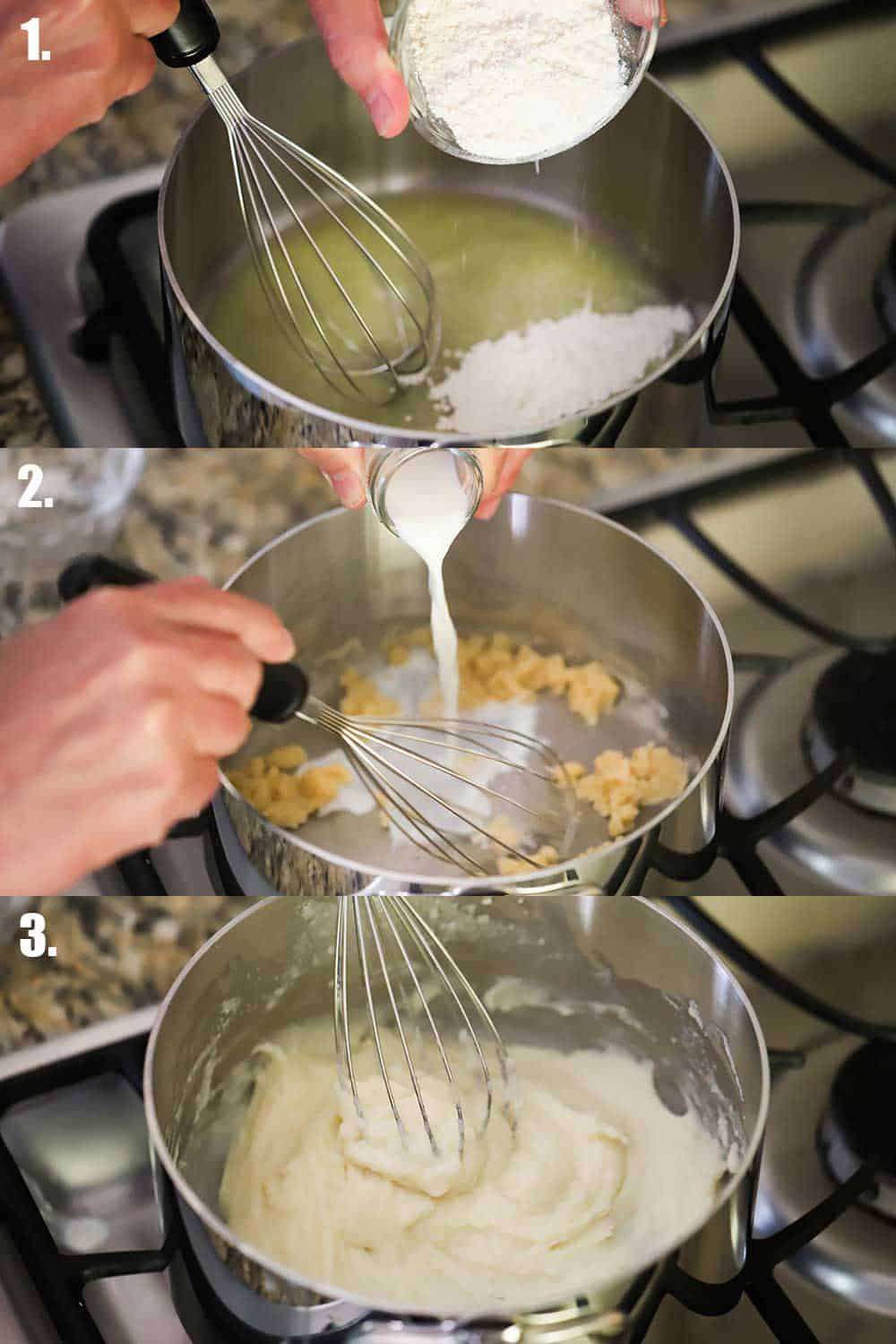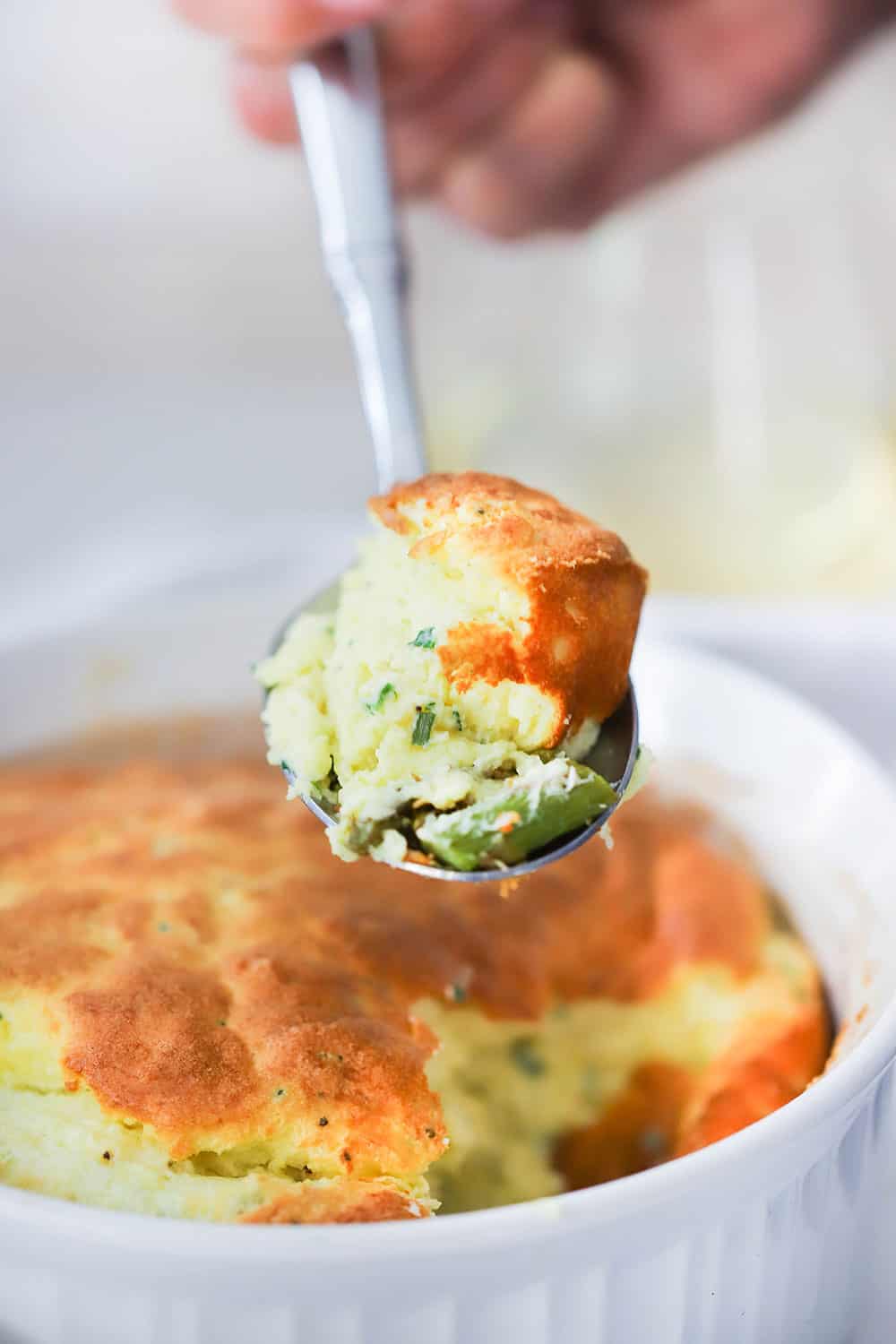This is a dish that so many home cooks fear they can’t pull off in their own kitchen. We’re here to quell that myth.
This classic French dish is actually not so difficult to make in your very own kitchen. You can serve this in a larger souffle dish or individual ramekins. It’s perfect for brunch served with our Roasted Tomato and Basil Soup and a green salad. Get ready to impress!

HOW TO MAKE THE PERFECT CHEESE SOUFFLÉ
There are few key things to remember when making a cheese soufflé that we will step you through.
Making sure your egg whites become stiff peaks, but not too glossy is one. Another is not allowing the dish to cook long enough, or opening the oven to take a peek too soon.
But honestly, it’s really not difficult at all!
ROASTING THE ASPARAGUS
A cheese soufflé, of course, is spectacular by itself.
But we think a nice layer of roasted asparagus pieces adds another dimension that is really wonderful.
EXPERT TIP: The asparagus can be made several hours in advance. To prepare the asparagus, trim the ends by about 1 inch. Use a peeler to peel the rough skin toward the bottom of each stalk. Cut the stalk into small bite-size pieces, about 1 inch each. Toss with a little olive oil, salt, and pepper, and then roast for about 10 minutes in a 400°F oven.
MAKING THE PERFECT BÉCHAMEL SAUCE
Every great soufflé starts with a perfect béchamel sauce.
In a medium-sized saucepan, melt 3½ tbsp of unsalted butter over medium heat. Don’t let the butter brown!
Add ⅓ cup of flour and stir until fully incorporated and resembles wet sand.
Next, slowly whisk in 1 cup of milk and continue stirring until very thick, about 3 to 6 minutes.
Now, it’s time to amp up the flavor.
We love adding Gruyere cheese (1 cup), but you can go with Swiss, white cheddar, Parmesan, or a combination of these. Dijon mustard and snipped chives round out the flavor profile.
EXPERT TIP: We think the snipped chives really deepen the flavor of this cheese soufflé. It may seem like 3 tablespoons is a lot, but as the dish cooks and rises, the ratio is just right. Use a whisk or wooden spoon to then gently incorporate the egg yolks in one at a time.
If you’ve ever wondered what causes the classic cheese soufflé to rise, it’s from beating air into the egg whites.
It’s best if the egg yolks and egg whites are at room temperature, but you’ll still be okay if they are somewhat chilled.
EXPERT TIP: We recommend using an electric hand mixer and a metal bowl to beat the egg whites into soft peaks. You want to stop as soon as you are able to lift the mixers out of the whites and small little peaks form. Don’t over mix or the whites will become glossy, which impedes the dramatic rise in the dish.
Gently fold about ⅓ of the whites into the egg mixture. Be careful not to over mix. It’s better to have a few streaks of egg whites in the mixture than to completely knock the air out of the whites.
THE SECRET TO MAKING A SOUFFLÉ RISE
So, gently incorporating the egg whites (that aren’t glossy) into the egg mixture is critical.
Baking the dish for exactly 27 minutes, with no opening the oven to peek, is the other key step.
EXPERT TIP: We use our 1½ quart soufflé dish for this recipe. But you can also do these in individual ramekins. We find that ramekins that are 3 to 4 inches in diameter and are 2 to 3 inches tall work best. They actually often produce a higher rise than the larger single dish.
Once the cheese soufflé is ready, bring it immediately to the table.
The dish will naturally start to deflate after it cools a bit, but is still delicious.
You will absolutely impress your guests when this is placed in front of them.
CHEESE SOUFFLÉ WITH ASPARAGUS FAQS
- Can I stir the roasted asparagus into the egg mixture? Yes! It’s delicious and very attractive that way, however, we do find that it causes the dish to not have as dramatic of a rise. It’s also kind of nice having a base layer of the asparagus.
- What else can be used in place of the asparagus? You can certainly go with cooked artichoke hearts for a wonderful option. We also like to sauté wild mushrooms or even fresh corn with some garlic and ginger, and then stir it right into the egg mixture.
- Will it still rise if I don’t separate the eggs? Yes, eggs naturally rise when they are baked. You’ll still get a delicious cheese soufflé, you just won’t get the dramatic rise.
- Can any of the dish be made in advance? The roasted asparagus can be made hours in advance. Other than that, for the best results, we recommend preparing the soufflé just before serving.
THE PERFECT BRUNCH OF LIGHT LUNCH DISH
This really is one of those “special moment” dishes, but honestly, once you make this, you’ll want to make it all the time.
We love serving it for special occasions such as a Mother’s Day brunch, or baby or wedding shower, or a romantic French lunch for two.
A nice crisp white Chardonnay wine is a wonderful accompaniment.
Ready to impress everyone with this classic French masterpiece? Go for it!
And when you do, be sure to take a photo of your masterpiece, post it on Instagram, and tag @howtofeedaloon and hashtag #howtofeedaloon!

Cheese Soufflé with Asparagus
Equipment
- 1 large soufflé dish (1 1/2 qt or 1.4 liters), or 4 small/medium ramekins
- Hand mixer or stand mixer fitted with the whisk attachment
Ingredients
- ½ lb asparagus ends trimmed, peeled, and cut into 1-inch pieces
- 1 tbsp olive oil
- 1½ tsp Kosher salt
- 1 tsp black pepper freshly ground
- 3 tbsp Parmesan cheese grated
- 3 tbsp unsalted butter plus more for greasing the dish
- ⅓ cup flour
- 1 cup whole milk warmed
- 1 cup Gruyere cheese grated
- 1 tsp Dijon mustard
- 3 tbsp chives finely chopped
- 1 tsp Dijon mustard
- 4 large eggs separated
Instructions
- Preheat oven to 400°F.
- Toss the asparagus pieces in the oil and sprinkle with ¼ tsp salt and ¼ tsp pepper.
- Place the asparagus on a baking sheet and roast in the oven for 10 minutes. Set aside.
- Liberally grease the soufflé dish (or ramekins) with butter. Sprinkle the Parmesan cheese all over the insides and bottom of the dish. It's okay if there is excess in the bottom of the dish.
- In a medium saucepan, heat the butter over medium-low heat. Add the flour and whisk to fully incorporate. Cook for 1 to 2 minutes. Don't let it begin to brown.
- Slowly whisk in the warmed milk, and bring to a simmer, or boil. Continue whisking and cooking until very thick, about 3 to 5 minutes.
- Remove from heat and mix in the cheese, Dijon, chives, ½ tsp salt, and ¼ tsp of black pepper.
- Gently stir in the egg yolks one at a time. Making sure they are fully incorporated before adding the next yolk.
- In a large bowl (metal or glass), add the egg whites with a pinch of salt. Use a hand mixer on high to beat them until soft peaks just form. Don't over-beat them!
- Add about ⅓ of the egg whites to the yolks/cheese mixture and gently fold them with a wooden spoon or whisk. Add the remaining whites and fold together until just combined. Don't overwork the mixture (it's okay if some white streaks are visible).
- Transfer the asparagus into the bottom of the dish and then pour in the egg mixture, using a spatula to gently smooth the top.
- Place the dish in the oven (400°F) and bake for 27 minutes.
- Remove from oven and serve immediately.













Happy aniversary <3
Thank you so so much!!!! xoxo